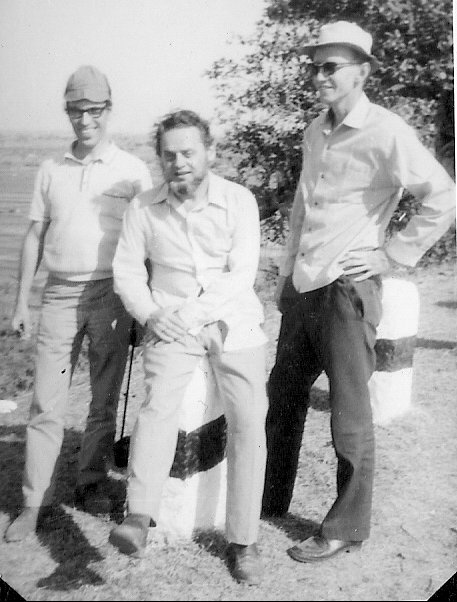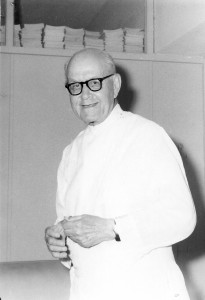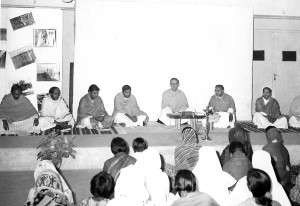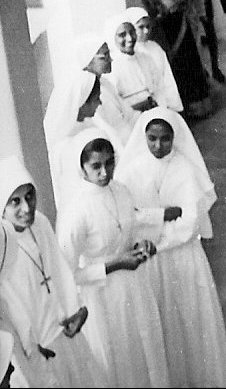In 1965 Fr Anthony Arulappa, a Telugu himself, wrote a letter to St John’s College. At the time he was director of the Catholic Centre in Madras. Later he would be elected Archbishop of Madras-Mylapore. In his letter he wrote:
“Until now we have run from here, in Tamilnadu, a correspondence course on Christ in Telugu. But Telugu is the state-language of Andhra Pradesh. Most of our enquirers come from Andhra. I feel it would be more appropriate for the course to be sent out from Hyderabad. Can you take over? I will send you all the printed copies of the lessons we still have.”
The letter landed on my desk since I was in charge of the apostolic academy of the college.
After reflection, I agreed with Arulappa. Telugu was only a secondary language in Tamilnadu but the principal language of Andhra Pradesh. Moreover, when I surveyed what the Catholic Church in Andhra Pradesh was doing in the field of the media, I was shocked. There were some small printing presses, one local Telugu Catholic weekly and two ragged monthlies. But a concerted effort to communicate through the modern media: the printed word, radio, TV, film, etc. were totally lacking. Something needed to be done.
I replied to Fr Arulappa asking him to send us the material he had – which he did. In the college I recruited a team of volunteers to take up the challenge of the correspondence course. I studied how the course worked.
Correspondence courses were actually highly effective at the time. More than 80% of the population lived in villages and their literacy rate was improving through better education. Bookshops were only found in towns. A trickle of copies of Telugu newspapers would reach a village. Few could afford to subscribe to them, but visitors to a local town might bring a copy home – which would then be passed on to friends and neighbours. The lessons of a correspondence course which were sent out through the postal service could reach almost anyone.
The system consisted in advertising a free Christian leaflet in the Telugu dailies: such as in the Andhra Prabha and the Andhra Bhoomi. Leaflets dealt with topics such as ‘Why I believe in one God’, ‘The Voice of Conscience’, ‘Your real beauty lies inside you’ or ‘The Parable of the Lost Son’. When a person ordered a leaflet, he or she would receive it with an invitation for him or her to join our information course on Christ. Our experience was that one on every four persons asking for a leaflet, would enrol in the course.
I ran the course with the help of my volunteer students for a year. We sent out thousands of lessons every month. I realised both that the potential was huge and that our amateurish attempt to run it from the college would not meet the task. So I took it to the Bishops’ Conference of Andhra Pradesh.
Giving birth to the new centre
The seven bishops showed little interest in setting up a new structure. They were more interested in the day-to-day survival of their 219 parishes with the 3230 mission stations served by these parishes. But fortunately Mark Gopu, the Archbishop of Hyderabad, listened to me. He was willing to support the new venture. And this, although part of the Archbishop’s mind still hovered in the Middle Ages. For instance, he did not want a telephone installed in Archbishop’s House, causing many unnecessary personal visits by priests, religious and lay leaders where a simple phone call would have solved a problem. Eventually a telephone was installed in the bishop’s office, without the bishop’s knowledge, by his Vicar General, Mgr Fernandes, when the bishop was away on vacation . . .

A valiant group of volunteers who helped a lot in our first office at St Patrick’s school: Sr Barbara, Gloria, Cecilia, Mrs Braganza, Victoria – I forgot the names of the others.
Anyway, Archbishop Gopu helped me acquire provisional premises for the new centre, to be called Catholic Information Centre, in the middle of Secunderabad. It consisted of one classroom released free of cost for this purpose by St. Patrick’s School. Now I needed to find staff, especially a competent person who could run it full time with the help of volunteers. That person, I reasoned, should preferably be a religious Sister or Brother, therefore someone committed to the apostolate and well trained.
As I will narrate in another chapter, I had by then been made moderator of the Conference of Religious, known as the CRI, in Andhra Pradesh. That gave me access to the superiors of the eight religious congregations working in the archdiocese.
Believe me or not, it took me five months to achieve my purpose. I met many superiors face to face and explained the need. I pleaded at general meetings of the CRI. The standard answer I received was that all the sisters (or brothers) had been trained to teach in schools or be nurses in hospitals and clinics. Mass media communication, and certainly just organising a correspondence course, was well above their radar. “Religious could not afford to waste a person”, I was told. Meanwhile the new centre limped on with the part-time help of some seminarians and primary-school teachers. I almost despaired.
The break-through came when one of the more conservative congregations, the Sisters of Charity, presented a candidate for the job: Sr. Attilia Saldanha, a trained librarian who had asked to be given a more apostolic task. She proved a God-sent. Her training provided the skills needed to set up a really professional administration. She was intelligent so that I could plan with her the design of new leaflets and the expansion to a range of better adapted courses, like the ten-lesson Meet Christ course for beginners and the forty-lesson Know Christ course for advanced enquirers. Attilia also got on well with her helpers the volunteers. And most of all, she was utterly committed to the task as a ministry, keen to help the enquirers who were looking for guidance in their life.
The correspondence courses were now beginning to flourish, but I knew we were not tackling all the other media projects the Church should be engaged in. Time to express my concerns in public.
Rallying cry
I found a compelling thought in the writings of Thomas Jefferson, one of the founding fathers of the USA. “Even when few are convinced of a certain mode of action, if among them there is one who sees a new light and has the courage to speak, if he speaks loudly and convincingly with good reasons, then though he be laughed at and ridiculed in the beginning, slowly there will be more to think like himself and all will come to see the new light.”
Good advice indeed!
So in 1971 I published a 16-page booklet with illustrations entitled: New Priorities in Andhra. Communications.[i] In it I described the various means of mass communications, their potential for India and what involvement would mean for the Church. And I passionately implored those responsible in whatever institution not to ignore this challenge.
“I feel it my duty to call the attention of all engaged in the apostolate to a number of undilutable facts, to a vision of new possibilities, to a few crying needs which should no longer be overlooked. In Christianity we are very much involved in the work of communication. We are communicating to people a new message, the Word of God, and we are communicating to them the grace, the forgiveness of our lord Jesus Christ . . .
It is practically impossible to overestimate the important role which the means of mass communication are playing and will play in the.future for the building up of Indian society. Let us take the example of the press. With a literacy rate that will steadily grow from its 24 percent, in the next ten years the printed word will assume increasing importance. It will spread to many homes, offices and other important places which preachers can never reach . . .
So also the radio has successfully conquered the hearts and minds of many in the nation. The radio services are effectively communicating to 40 million people of Andhra Pradesh . . . It is also well known how films have already begun to mould the ideals and aspirations of Indian communities. India is now the largest film producing country in the world. The number of cinemas and film-goers is still increasing. Likewise, the greatest potential force of the future is television . . .
In view of all this, the task that lies before the church in this field is enormous, it requires a thorough program of re-education on all levels, so as to arrive at a positive appreciation of these means of communication. When we work in Christ’s service we should never forget that the aim we should have in mind is not first and foremost the establishment of external structures in stone or concrete, is not the production of material for impressive statistics: it is first and foremost the change of heart and the acceptance of faith that must live in people’s hearts.”
To my delight, the Catholics of Andhra Pradesh began to respond. To give some examples: Bishop Ignatius Mummadi of Guntur Diocese released Fr Yeruva George to start a department for producing Telugu books. I got scholarships for Mr Thumma George and Fr Marneni Julian to study communication courses in Manila, with a view of opening a radio department. The JMJ Congregation released a Telugu Sister to write personal letters in Telugu to enquirers who had asked questions.
Our Centre in St. Patrick’s school was expanded with one more room. But it became clear that much better premises would be needed.
Planning a new home
In 1971 Archbishop Mark Gopu suddenly died. His successor, Samineni Arulappa, showed even more interest in the communication apostolate. When I went to discuss my vision of establishing a new permanent base for the Information Centre, he promised full cooperation. In fact, he showed me a plot of land right in the centre of Secunderabad, owned by the archdiocese, which he was willing to give for the project. An old decrepit house stood in the middle of the plot. It was known as ‘the widows’ home’. Recent monsoon rains had penetrated deeply into the roof and walls of the building. The house was literally crumbling.
“I can find alternative accommodation for the women who live there”, the archbishop stated. “You can build your new centre here.”
I was delighted. But for the project to succeed I needed money. I drew a rough sketch of a small two-storey building which, I thought, would do. Then I dashed off on a lightning trip to Europe to dig up finances. Three encounters would prove crucial to my eventual success.
Dr Joseph Eilers SVD at the Catholic Media Council in Aachen looked scornfully at my drawing. He told me that experience in other countries had shown that I should ‘think big’ and not start with tiny structures that would prove inadequate in just a short time. He also advised me to design the Centre in two halves: a rear end for offices used by the Centre, but also a front half for offices that could be rented out to outsiders to create income.
His ideas struck me as brilliant. I immediately revised my plan as he suggested. The building now encompassed a larger area and was to be 4-storeys tall.
With the new plan and a recommendation by Dr Eilers I visited Missio, also in Aachen, and submitted an application. Then I travelled to the Hague in the Netherlands to meet with the organisers of a new Dutch initiative called Kom Over De Brug, a one-off campaign to support major projects in mission countries. I was lucky. The secretary of KOB assured me that my application was just the kind of project they were looking for . . .
The crisis
I could not believe my luck when soon afterwards, in 1973, I got the news that my applications to Missio and KOB had been accepted. I received the money needed for constructing the new building. Fantastic! I got an architect to draw up detailed plans. Also, knowing that I had no experience at all in construction business and would not have the time to oversee the actual building works, I pulled off another miracle. I managed to secure the services of Brother Hubert de By MHM, who until then had been working at St Joseph’s Technical School in Cuddapah.
So far so good. In September, at the end of the second mini-monsoon when a regular flow of water for cement mixing was assured, I told the contractor to go ahead and start the work on site. The Archbishop of Hyderabad laid the foundation stone and said a prayer. Since the building firm had a Hindu work force, a coconut was then broken in front of a statue of Ganesh. Drinks and cakes were served. The digging of the foundations started under Hubert’s competent guidance.
Then the first blow. A government inspector visited the site, looked at the plans and declared them unfit. However, he would allow us to go ahead, he said, if we gave him an enormous bribe. Building works were halted.
I was just on the way to Bangalore to give a four-day course on Scripture at the NBCLC when I got the news. What could I do? Our budget was tight, but any delay would cost us money as we had to keep paying the contractor. Moreover, after some days the secure flow of water might stop thereby seriously hampering construction. The blackmailing inspector was well aware of this.
At the NBCLC I met a well-known moral theologian, Fr Finbar O’Connolly. He was a good man and I had a lot of confidence in him. I put my case to him.
“I feel I will have to give the bribe”, I said.
“I advise you strongly against it”, he replied. “You may not do so with a clear conscience. Yes, it may be robbery but by giving the bribe you condone all the corruption that is constantly going on in Indian society. Don’t do it.”
In the plane on the way back to Hyderabad I carefully weighed up his argument. Obviously I did not want to condone corruption. But if it was robbery, as was clear in this case, how far did we need to go in opposing it? If a thief were to assault me and demand my money on pain of harm or death, I would gladly hand over my money . . . So as soon as I arrived back in Hyderabad I gave orders to pay the bribe, and building works resumed.
I had hardly recovered from this upset and from my moral torment, when a second, even heavier blow, struck. Just two weeks later, in October, the first global oil crisis happened. Within a short time the cost of a barrel of oil rose from $3 to eventually $12. This had a knock-on effect on other building supplies such as cement and bricks. The whole world reeled under the financial turmoil and it hit India worse than elsewhere.
I suddenly found that the increased cost of building material would cause a shortfall in our budget of 3-4 lakhs of rupees (Rs 3-400,000) an enormous sum at that time. And, remember: the building work was going on. I could not stop it . . .
I turned for an immediate loan to all church authorities I knew. Everyone refused: the archbishop and all the other bishops, religious superiors and heads of Indian Charities. I knew that some of them had the capital to help me out on a short time basis. But in spite of all my pleas, they threw responsibility back at me. “This is your pet project, your baby. Sort it out yourself!”
It is difficult to describe the agony I went through. Big action was called for.
I travelled back to Europe and visited Missio again. KOB had wound up its campaign. I explained to the new Secretary General of Missio what had happened, but he dismissed me, saying that Missio could not give loans and that I had to complete the project within the budget I had submitted in my application. “The world oil crisis is no valid excuse!”

Ferdinand Luthiger, Dr Willi Dober and I.
Fortunately I had got to know Swiss Lenten Fund at that time. Ferdinand Luthiger, the project manager for Asia, and a commercial expert, Dr Willy Dober, were due to visit India soon as I have recounted in the previous chapter. I met them and persuaded them to use the occasion to judge the situation for themselves.
This eventually saved the day. Ferdinand Luthiger and Willi Dober visited the building site and declared that the sudden financial upset was not due to mismanagement on my part. Catholic Media Council endorsed this too. Finally, just in time for us to complete the building, various Catholic agencies, including Missio God bless them, released a further grant to cover the debt.
It is a miracle that I survived that crisis in one piece – and still breathing!
Phenomenal growth
At the advice of Mr G.S.Reddy, a Catholic member of the Indian Parliament in New Delhi, we chose a truly Indian and Telugu name for the Centre. From about a hundred options which wide consultation had produced, we chose Amruthavani. ‘Vani’ means ‘voice’, ‘sound’. ‘Amrutha’, from Sanskrit for ‘immortal’, stands for the sweet nectar the gods and goddesses drink in paradise. Amruthavani expresses ‘the good message’ in a truly Indian metaphor.
I also commissioned Dr A.C. Jesurajan SJ who had just completed doctorate studies in Manila to conduct a thorough inquiry into Amruthavani and what its priorities should be in the Andhra Pradesh of the time. His excellent report produced reliable guidelines on the printed word, radio, film, TV and traditional folk media. Although the printing of his report in Mumbai exhausted the last penny of our budget, it paid for itself in the course of years to come and gave us backing for funding agencies abroad.

Fr M M Balaguer SJ, Director General of Amruthavani.
While the structure was rising, I had also started concentrating on attracting more competent staff. I knew that my full-time teaching job in St John’s College would prevent me from giving the Centre the twenty-four-hour leadership it would need. So I used my nation-wide travels, giving courses and attending meetings, to recruit an overall director. I was determined to find the best.
After two years my search was rewarded. Fr M.M. Balaguer SJ took the job of Director General. He had a good track record. For years he had held top jobs such as being the principal of the renowned St Xavier’s College in Mumbai and being overall in charge of all 2000 Jesuits in India undergoing training. Balaguer was both a saintly priest and a man of great vision.
He was soon joined by Fr Raymond Ambrose of Hyderabad Archdiocese who became the Executive Director of the Centre. In all my life I have not met someone who could match his dynamic and creative style of organisation. I retained the position of Director of Planning.

Left to Right: Fr AC Jesurajan, Fr Christopher Coelho, Fr Y. George, Fr. Raymond, myself, Fr Mariadas and Fr PD Varkey presiding at a Mass for Amruthavani staff.
By the time I had to leave India in 1976, Amruthavani had 12 flourishing departments with more than 70 capable staff. It would take me too long to describe the progress made in the many different areas. A correct impression of the work going on can be gained from studying the photo gallery offered to me as an album during the ceremony at which I took an emotional leave. The gallery can be found online here.
[i] J.N.M Wijngaards, New Priorities in Andhra. Communications, Amruthavani, Hyderabad 1971.
John Wijngaards, My Story – My Thoughts, Part Three. MISSION IN INDIA
THE STORY OF MY LIFE
- » FOREWORD
- » Part One. LEARNING TO SURVIVE
- » origins
- » into gaping jaws
- » from the pincers of death
- » my father
- » my mother
- » my rules for survival
- » Part Two. SUBMIT TO CLERICAL DOGMA — OR THINK FOR MYSELF?
- » seeking love
- » learning to think
- » what kind of priest?
- » training for battle
- » clash of minds
- » lessons on the way to India
- » Part Three (1). INDIA - building 'church'
- » St John's Seminary Hyderabad
- » Andhra Pradesh
- » Jyotirmai – spreading light
- » Indian Liturgy
- » Sisters' Formation in Jeevan Jyothi
- » Helping the poor
- » Part Three (2). INDIA – creating media
- » Amruthavani
- » Background to the Gospels
- » Storytelling
- » Bible translation
- » Film on Christ: Karunamayudu
- » The illustrated life of Christ
- » Part Three (3). INDIA - redeeming 'body'
- » spotting the octopus
- » the challenge
- » screwed up sex guru
- » finding God in a partner?
- » my code for sex and love
- » Part Four. MILL HILL SOCIETY
- » My job at Mill Hill
- » The future of missionary societies
- » Recruitment and Formation
- » Returned Missionaries
- » Brothers and Associates
- » Part Five. HOUSETOP LONDON
- » Planning my work
- » Teaching teaching
- » Pakistan
- » Biblical Spirituality
- » Searching God in our modern world
- » ARK2 Christian Television
- » Part Five (2) New Religious Movements
- » Sects & Cults
- » Wisdom from the East?
- » Masters of Deception
- » Part Five (3). VIDEO COURSES
- » Faith formation through video
- » Our Spirituality Courses
- » Walking on Water
- » My Galilee My People
- » Together in My Name
- » I Have No Favourites
- » How to Make Sense of God
- » Part Six (1). RESIGNATION
- » Publicity
- » Preamble
- » Reaction in India
- » Mill Hill responses
- » The Vatican
- » Part 6 (2). JACKIE
- » childhood
- » youth and studies
- » finding God
- » Mission in India
- » Housetop apostolate
- » poetry
- » our marriage

